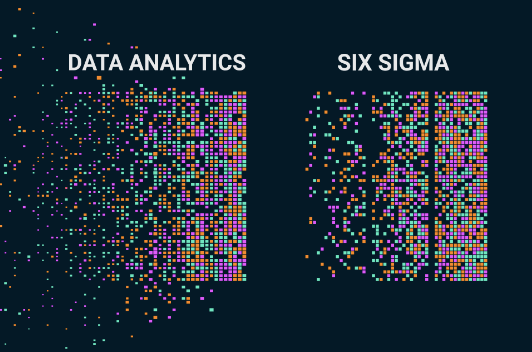With the rise of Big Data and Data Analytics in the past few years, there has been a buzz around how it can be used in Six Sigma and the other way round.
Six Sigma is a structured, data-driven methodology that focuses on identifying the defects based on the rigorous statistical analysis to optimize the process. This is achieved by conducting an effective root cause analysis based on data analytics. This sort of statistical approach to problem solving benefits from data analytics tools that make the process simpler.
Data Analytics is exploratory. It involves setting up an automated process of collecting data and then manually analyzing a dataset to search for patterns.
Six Sigma relies on hand-picked values as the amount of data collected in a Six Sigma Project is a lot smaller. However, this approach has obvious limitations while dealing with big data and this is where Data Analytics enters into the game!
But still, this is not as easy as it may look. All the problems associated with small data are still present with big data such as missing entries, sampling bias, incorrect data entry, overlooked critical variables, etc and one needs to address each of these issues before moving to the analysis.
At this stage, it’s still a challenge as how to analyze the data and the appropriateness of the methods of analysis you are using. You still have to think about of the results of your analysis and what they will mean with respect to actual improvement – failure to do this will guarantee you will go wrong with great assurance.
DMAIC is a Six Sigma Methodology, stands for Define-Measure-Analyze-Improve-Control, help the existing processes to improve using a wide range of tools & techniques. There are certain suits of Data Analytics can help to optimize the process in three of the phases of DMAIC cycle of Six Sigma methodology for Quality Improvement.
Online Six Sigma Training offers the privilege to get rid of all the above problems, providing convenience & yet save a huge amount of time, efforts & money.
Through DMAIC methodology, we are most typically solving a process-oriented problem affecting quality as a whole, with a fundamental principle as Y= f(x) where Y is an output and X represents inputs. We use Data Analytics to find those X values. Interestingly, this can be true in Data Analytics as well, but the context and scope can be much wider and some of the tools we apply in Data Analytics would not be as well-suited for DMAIC or Six Sigma and vice-versa.

Some tools such as Exploratory Data Analysis (EDA), Correlation, Regression Modeling, etc are common to both. But Fundamental Analytics will go further into tools such as Cluster Analysis (special groupings of customers for instances), Association Rules, Naive Bias (classifying emails or social media content as spam or not, positive or negative) and so on. To the points above however, both endeavors should follow a methodology.
The real difference is Six Sigma uses statistically based small sample sizes to unlock the knowledge. Big Data uses relatively huge (almost population sized) data and looks for the statistically identified trends or patterns to unlock the knowledge. The point in Data Analytics is to use data to gain Insights whereas in Six Sigma is to use such Insights to get potential solutions of the problem and implement it to success.
The proven strength of DMAIC to solve your quality issues can be enhanced by utilizing the tools and techniques provided by Data Analytics. In short, it is not a case of Six Sigma vs Big Data, rather it is a case of correctly analyzing Big Data using the methods of Six Sigma.
Little about e-Six Sigma
e-Six Sigma is a venture by IIM-Alumnus & Ex-Infosys. Shifted from ‘Classroom to Cloud’, it has trained over 2000 professionals and students on Six Sigma.
e-Six Sigma is an exceptionally good in making you gain the Six Sigma Skills in the most convenient and result-oriented manner through its Award-Winning & Unique Training Delivery Model which is a right combo of Theoretical & Practical Exposure.
You can start learning them at any point of time and with e-Six Sigma, you will have the advantage of learning them at your own time-convenience and pace, even on your smartphones! e-Six Sigma empowers you to make the most of it from day 1 by teaching you to save time in learning and we all know that time is money! So don’t waste time aka money and enrol in just a minute at www.esixsigma.in. Happy Learning!


